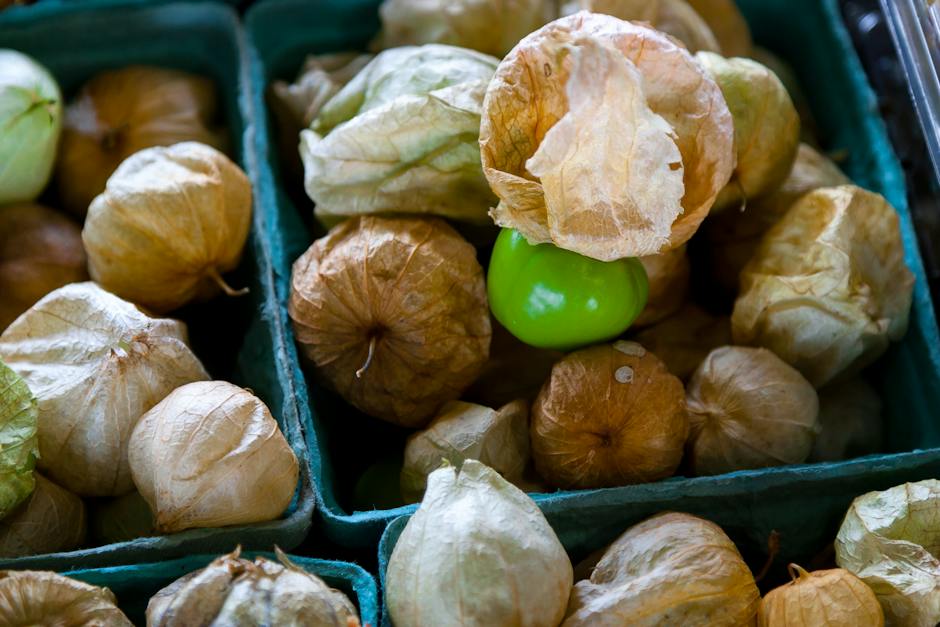Spotting Ripe Tomatillos: A Simple Guide

In a world teeming with an array of delectable produce, tomatillos hold a unique place, offering a distinctive blend of tart and sweetness that elevates any dish they are added to. The key to unlocking this carefully balanced flavor profile though, lies in knowing the right moment to harvest these small green gems. As such, our exploration into tomatillos’ ripeness will commence with understanding the growth cycle of these fruits. It’s a journey that begins with a tiny sprout, followed by the blossoming of flowers and culminates in a beautiful display of vibrant, nutrition-packed green orbs. Along this journey, you’ll learn to recognize the physical changes a tomatillo undergoes as it transitions from unripe to perfectly ripe. Such indicators include changes in the fruit’s color, size and the condition of its protective husk.
Understanding Tomatillos Growth Cycle
Entitled: “The Life on Your Plate: Tracking the Growth Cycle of a Tomatillo”
Ah, the humble tomatillo. More than just a funny word, this vibrant fruit adds an acidic zing to a myriad of delectable dishes. While it may conjure images of salsa verde dancing in gourmand minds, there’s a complex journey behind each one. Understanding the growth cycle of a tomatillo can boost the appreciation of this underrated treasure and provide fundamental knowledge for home gardeners seeking a new challenge.
So, what makes the tomatillo tick? The answer stretches out over six intriguing stages, from seed to salsa.
- “Seeding & Germination”
- “Seedling Stage”
- “Transplant & Growth Set Up”
- “Growth & Developing”
- “Fruit Formation & Maturity”
- “Harvesting”
Enter the intriguing world of tomatillo propagation. For the best start, seeds need to be sown indoors about 6 to 8 weeks before the last expected frost. The seeds will germinate in about a week when exposed to temperatures about 70°F. Peat pots or cell packs, filled with a good potting mix, work ideally. Keep them well-watered, but not waterlogged – tomatillos are little Goldilocks in pots!
Seedlings can be seen in 1-2 weeks after germination. Here, the burgeoning tomatillos are starting to develop their basic structure. After three weeks, and once the threat of frost has passed, these young upstarts are ready to rough it outdoors.
Tomatillos don’t go solo. They are a friendly bunch that needs at least two plants to allow for proper pollination. So, remember to plant them 3 feet apart in a sunny part of the garden. To show their appreciation, they’ll reward culinary adventurers with the juiciest of fruits.
Embrace patience as the tomatillo plants grow unassumingly during the 75 to 100-day duration to maturity. Here, they begin to sport yellow, star-shaped flowers that are the precursors to the celebrated fruits.
These dazzling flowers will soon give way to tiny, green, tomato-like fruits enveloped in delicate, evidently papery husks. A curious characteristic of tomatillos is that the husk develops before the fruit. So, watching that husk swell to size over weeks is gleefully suspenseful.
Time to play in the kitchen again! Harvest your tomatillos when the fruit fills the husk or the husk begins to split. Allow the fruit to mellow to a deep green and feel slightly soft but not squishy.
Caring for these quirky fruits is a joy. The exotic nuances of peppered citrus elevate any dish, demonstrating that behind even the humblest ingredient hide layers of explosive flavor. Relish in a tomatillo’s journey from a humble seed to a tangy delight, as it brings not just color but also a tale of growth to your plate. The adventurous palette isn’t satiated solely by flavors, but by the stories behind the meal. Dive headfirst into culinary gardening and discover how food truly does connect us, from our homes to our tastebuds, and through the shared learning on our plates.

Physical Indicators of Ripeness
A Flavor Journey: Physically Knowing When Your Tomatillos are ripe!
Avid gardeners and culinary enthusiasts alike would agree: food tastes better when you’ve guided its journey from seedling to plate. Let’s dive into the final, crucial element of the tomatillo lifecycle – identifying the ripe ones.
A tomatillo, also known as the Mexican husk tomato, is a tangy, sweet, and versatile ingredient. While no two tomatillos are exactly alike, the telltale signs of ripeness remain constant across different varieties. Here are some physical signs indicating a tomatillo is ripe and ready to take your whisked-up salsa or simmering stew to a new level of deliciousness.
- Firstly, considerable size plays a vital role. High-quality, ripe tomatillos are often about the size of a golf ball, perhaps slightly larger. The small, immature fruits tend not to have developed the full flavor spectrum yet. When you’ve got a tomatillo sighting that mirrors a playful tee-off, you’re on track.
Next, turn your attention to the husk. As the tomatillo ripens, it expands inside its paper-thin husk, eventually filling it completely. A tomatillo that has filled its husk, or even stretched it a bit, is your signal.
Color is another significant factor. A vibrant, lush green hue throughout the tomatillo indicates optimal ripeness. However, remember that some varieties like the Purple De Milpa tomatillo change into rich purple as they ripen.
Lastly, feel that firmness. A ripe tomatillo should be firm but not hard when gently squeezed. Too soft and it may be overripe, potentially leading to a subpar taste experience.
Armed with these clues, you’re well equipped to spot ripe and ready tomatillos from your homegrown vine, at the farmer’s market, or even the grocery aisle. From here, the culinary magic is boundless, transform this jewel of a fruit into a salsa verde, or a rich twist in your wholesome chili recipe.
Believe wholeheartedly in the journey of every ingredient, exploring the nuances of growth and ripeness, and recognizing the precise moment of harvest. After all, it’s not just about feeding our bodies, but feeding our palates. Taste is the ultimate language, bridging gaps and connecting us all through shared, savored experiences. Your ripe tomatillos are more than just ingredients; they’re stories waiting to be relished.

Taste verification
Delving into the world of flavors, one can’t ignore the enticing taste of ripe tomatillos. The taste of tomatillos, when they are ripe, will elevate any dish from ordinary to extraordinary. Enriched with a tangy, slightly herbal flavor, ripe tomatillos bring a zestful punch that gets along splendidly in various dishes — from salsas to stews, soups, and sauces.
Picture a small, unripe tomato that decided to go on a tropical vacation, soaking in the sunshine and surf, only to come back with a zest for life – that’s what a ripe tomatillo tastes like. There’s a subtle sweetness lurking behind the tartness which, when paired with the right ingredients, gives a nuanced flavor profile that takes your taste buds on a delicious rollercoaster ride.
The individuality of the tomatillos lies in its tang, a delightful tartness that is not found in common tomatoes. This savory element keeps the palate intrigued, making the consumer search for more depth in the dish. Balanced against the tartness is a slight sweetness, which rounds off the taste beautifully, creating a complex flavor profile that connoisseurs appreciate greatly.
The green tomatillos are slightly acidic and sharp, while the riper, yellowish ones provide a bit more mellow and sweet flavor. When cooked, these vibrant fruits tend to lose their tartness and their flavor takes on a delightful mellow richness. The process of cooking the tomatillos also enlightens their innate flavors, bringing forward an undeniable tangy sweetness that contradicts yet complements their initial sharp nature. Isn’t that delightful about food science?
Recognizing ripe tomatillos is equal parts art and science. The best indicator is the husk. As the fruit ripens and grows, it expands inside the papery husk, which splits open when the fruit is ripe and ready to be relished. The color is a good cue too, changing from bright spring green to a muted, yellowish-green. Moreover, ripe tomatillos are characteristically firm to the touch.
Unleashing the culinary possibilities of ripe tomatillos is an exciting venture for any food lover. From constructing a spicy, tangy salsa verde, grounding a flavorful stews, to jazzing up a humble soup, the flavor possibilities are simply limitless. With each recipe, you’ll be drawing on the vigorous and unique flavor of the tomatillos, ensuring your meal is a transcendental journey from the ordinary to the extraordinary.
The diverse range of uses and unparalleled taste of ripe tomatillos reminds us to appreciate the delightful journey an ingredient takes from being a seed to the star of your dish. Understanding a tomatillo’s growth cycle and recognizing its ripeness contributes to our appreciation of the food we eat, making our culinary experiences more profound.
The significance of taste in the culinary experience is undeniably incredible. It unlocks emotions, triggers memories, and, most importantly, connects us deeper with the food we eat and the people we share it with. So, the next time you relish a dish with tomatillos, remember to appreciate their unique taste and the journey they’ve taken to land on your plate. Happy cooking, and even happier eating!

Finally, we will delve into the method of confirming tomatillo ripeness through taste. A juicy bite into a ripe tomatillo can tell you more about its readiness than any theory can. A ripe tomatillo reveals its maturity in a dance of flavors and textures, providing a rich tartness, a hint of sweetness and a burst of juiciness. By fully understanding the growth cycles, observing physical changes, and relying on our own taste buds, we empower ourselves to determine the ideal time to use tomatillos in our meals, maximizing their delectable contribution to our culinary endeavors.



